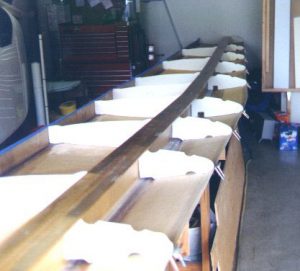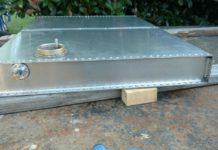
The original G-I wing can take advantage of a number of later kit components and component locations.
First the fuel tank capacity can be increased from the original 34 gallons to the 40 gallons of later kits by relocating the outboard fuel tank rib. Rather than listing new locations in this article I would prefer to provide builders with photocopies pages from the later manuals.
In conjunction with lengthening the fuel tanks in the wing leading edges the gas caps location should be moved outboard as well. This gas cap relocation is also best done using copies of pages from later manuals. I also highly recommend that the new style (twist and latch to lock) be installed in place of the “thermos” style (it is a lot easier to do the switch while building the wing rather than retrofitting after wing closure). I also recommend that a gas cap be installed in both the left and right wing. This simplifies fueling and makes confirmation of wing tank full condition much more certain.
Secondly the builder of a G-I wing can greatly simplify the fuel tank centersection with its extra baffles and transfer tubes by using the flapper valves (332-1441-101 & 102) supplied with later kits. These flapper valves are much simpler and easier to install that the crossover tubes and extra baffles described in the Addendum’s and Instruction Manuals.
Another change that occurred between the G-I and G-II was the introduction of flat undersurface ailerons and flaps. The flat undersurface aileron tends to require less control force inputs at higher speeds. It was fairly common amongst G-I builders to flatten the aileron undersurface with a foam panel and another exterior surface. Those still building the ailerons many wish to purchase the G-II lower aileron panel (which is already flat) to save weight and building time.
Another time saver on the ailerons would be the incorporating the G-II aileron counterweights. The original G-I Instruction Manual required the builder to fabricate and cast his own aileron counterweight.
A flat lower surface flap panel is also available. Use of the flat panel for the flap would be to cosmetically match the flat aileron but also may “lighten” the flap loads when using the Manual flap actuating system. I like to suggest to builders however, that using the electric motor activation for the flap system is really the way to go. The electric motor drive gets the manual handle out of the cockpit and eliminates the awkwardness of getting the manual flap handle to the maximum deployed position. When flying our G-I FT with the original mechanical flaps I found I often would not use the last extended detent because it was just so awkward to use. With electric motor drive we now will always use full flap when landing and enjoy the ease of operating the flaps in the busy environment of the traffic pattern.
Wing tip treatment is another area of upgrade. The original G-I wing tip was rounded with lenses in front and rear for the navigation lights. The later G-II Hoerner tips can be retrofitted to the stock wing G-I wing to give the more modern look of the G-II. Use of the Hoerner tips will however require that the builder also install a taillight in the rudder or the external tip light assembly from Grimes.
The above list is intended to be a broad overview of upgrades possible for the G-I wing. If you have additional questions or wish more details feel free to contact me at NewGlasair during the Tech Support hours Tues, Wed, and Thurs, 1 PM to 3 PM each day.



